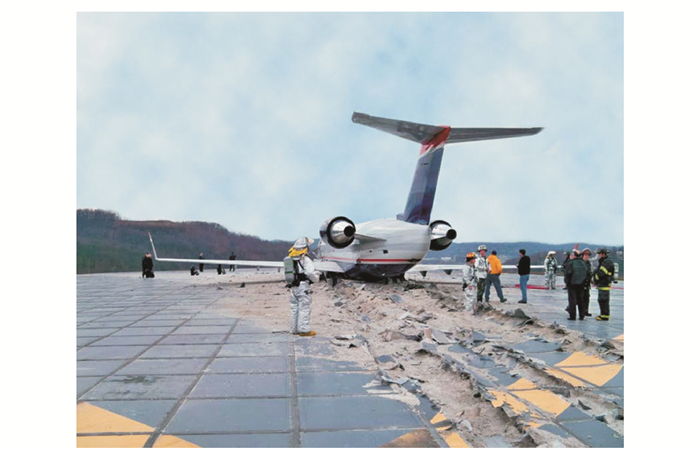Performance deterioration law of foam concrete in airport arresting system under seawater corrosion
-
摘要: 为评价工程材料拦阻系统(EMAS)在海岛机场的适应性,研究了拦阻系统中泡沫混凝土在高温、高湿和高盐环境中的性能劣化规律;研制了可自动控温、鼓风与补水的全(半)浸泡一体试验装置,分别研究了泡沫混凝土浸泡在30 ℃清水、30 ℃与60 ℃模拟海水中吸水率、变形、压溃强度与半溃缩能等宏观性能的衰变规律;借助X射线断层扫描技术获取了泡沫混凝土的微结构信息,并利用X射线衍射分析技术表征了泡沫混凝土受溶液侵蚀后物相种类与含量的变化。研究结果表明:泡沫混凝土耐海水侵蚀性能较差,在30 ℃清水中浸泡90 d后,其压溃强度降低了11.5%,而浸泡在30 ℃与60 ℃模拟海水中,其压溃强度分别降低了19.9%与52.1%;全浸泡在30 ℃清水与30 ℃模拟海水中时,泡沫混凝土的吸水率性线增大,90 d时约为280%;模拟海水温度升高至60 ℃时,泡沫混凝土浸泡10 d后的吸水率快速增大并稳定在350%左右;泡沫混凝土内部孔隙率为70%,平均孔径为2.0 mm,二维贯穿深度约为8.4 mm,导致溶液极易侵入泡沫混凝土;泡沫混凝土中孔径较大,盐水很难在毛细作用下向上传输,表面未出现盐结晶现象,数次吸水膨胀与风吹干燥收缩循环致使泡沫混凝土表面粉化严重;溶液侵入泡沫混凝土内部,同时引起基体软化、钙溶蚀与离子侵蚀反应,加速了泡沫混凝土的骨架损伤,使其压溃强度降低;工程实践中应尽可能避免海水拍打、礁石撞击单元体,并对单元体及泡沫混凝土做防水处理,以确保EMAS长期稳定有效。Abstract: To evaluate how an engineered material arresting system (EMAS) can be applied in island airports, the performance deterioration laws of foam concrete of the arresting system at high temperature, high humidity and high salinity were investigated. An integrated full (semi) immersion test device was designed, wherein the temperature, air flow, and water volume could be controlled automatically. The deterioration in the macroscopic performance, namely in terms of water absorption, deformation, crushing strength, and half crushing energy, of the foam concrete soaked in freshwater at 30 ℃, simulated seawater at 30 ℃ and 60 ℃, was analyzed separately. The microstructure of foam concrete was examined via X-ray tomography, and the changes in the phase type and content of foam concrete after the solution corrosion were analyzed via X-ray diffraction. Research result demonstrates that the foam concrete cannot satisfactorily resist the seawater corrosion. After the foam concrete is soaked in the freshwater at 30 ℃ for 90 d, the crushing strength decreases by 11.5%. After it is soaked in the simulated seawater at 30 ℃ and 60 ℃, the crushing strength drops by 19.9% and 52.1%, respectively. When it is fully immersed in the freshwater and simulated seawater at 30 ℃, the water absorption increases linearly with time and reaches approximately 280% at 90 d. When the foam concrete is soaked in the simulated seawater at 60 ℃, the water absorption increases rapidly and levels off at approximately 350% after 10 d. The internal porosity and average pore size of foam concrete are 70% and 2.0 mm, respectively. Moreover, the two-dimensional penetration depth is approximately 8.4 mm. Therefore, it is extremely easy for the foam concrete to undergo corrosion. In addition, the relatively large pores render the upward transportation of saltine water under the capillary action difficult, so the salt crystallization is not noted on the surface of foam concrete. The foam concrete is powdered seriously after several cycles of water absorption expansion and wind drying shrinkage. Solutions can reach the interior of the foam concrete, leading to reactions such as matrix softening, calcium dissolution, and ion corrosion, thereby accelerating the damage to the foam concrete's skeleton and lowering its crushing strength. In practical engineering projects, unit bodies of EMASs should not be struck by seawater and reef as far as possible. Furthermore, the unit body and foam concrete should be made waterproof such that the EMAS can last long and function effectively. 3 tabs, 14 figs, 33 refs.
-
Key words:
- pavement engineering /
- foam concrete /
- microstructure /
- water absorption /
- length change /
- crushing strength /
- half crushing energy
-
图 1 EMAS拦停飞机案例[21]
Figure 1. Example of successfully aircraft arrest via EMAS
表 1 胶凝材料与调凝剂的主要技术性质
Table 1. Main technical properties of cementitious material and adjustable solidification agent
原材料 抗压强度/MPa 抗折强度/MPa 凝结时间/min 比表面积/(m2·kg-1) 3 d 28 d 3 d 28 d 初凝 终凝 胶凝材料:P·II 52.5R硅酸盐水泥 40.2 60.1 7.2 9.4 148 206 385 调凝剂:R.SAC 42.5硫铝酸盐水泥 45.2 50.2 6.4 7.9 35 66 352 表 2 泡沫混凝土性能劣化试验方案
Table 2. Test schemes for performance deterioration of foam concrete
方案编号 浸泡状态 侵蚀溶液 浸泡温度/℃ 风速/(m·s-1) Z1 全浸泡 清水 30 Z2 全浸泡 模拟海水 30 Z3 全浸泡 模拟海水 60 Z4 半浸泡 清水 30 5 Z5 半浸泡 模拟海水 30 5 Z6 半浸泡 模拟海水 60 5 表 3 泡沫混凝土内部孔结构信息统计结果
Table 3. Statistical results of pore structure information in foam concrete
与侧壁距离/mm 孔隙率/% 平均孔径/mm 不同面积(mm2)的孔数 1 (1, 100] > 100 5 60.24 1.26 11 408 1 257 23 10 71.14 2.09 9 566 748 30 50 70.06 2.02 9 227 725 32 -
[1] HEYMSFIELD E, HALE W M, HALSEY T. Aircraft response in an airfield arrestor system during an overrun[J]. Journal of Transportation Engineering, 2012, 138(3): 284-292. doi: 10.1061/(ASCE)TE.1943-5436.0000331 [2] YANG Xian-feng, YANG Jia-ling, ZHANG Zhi-qiang, et al. A review of civil aircraft arresting system for runway overruns[J]. Progress in Aerospace Sciences, 2018, 102: 99-121. doi: 10.1016/j.paerosci.2018.07.006 [3] 盛荣武. 特性材料拦阻系统(EMAS)在西藏林芝高高原机场的首次应用[J]. 科学咨询(科技·管理), 2018(32): 62-64. https://www.cnki.com.cn/Article/CJFDTOTAL-KXZC201808051.htmSHENG Rong-wu. First application of engineered material arresting system (EMAS) at Tibet Linzhi High Plateau Airport[J]. Scientific Consulting (Technology and Management), 2018(32): 62-64. (in Chinese) https://www.cnki.com.cn/Article/CJFDTOTAL-KXZC201808051.htm [4] FONT A, SORIANO L, MONZÓ J, et al. Salt slag recycled by-products in high insulation alternative environmentally friendly cellular concrete manufacturing[J]. Construction and Building Materials, 2020, 231: 117114. doi: 10.1016/j.conbuildmat.2019.117114 [5] KASHANI A, NGO T N, MENDIS P, et al. A sustainable application of recycled tyre crumbs as insulator in lightweight cellular concrete[J]. Journal of Cleaner Production, 2017, 149: 925-935. doi: 10.1016/j.jclepro.2017.02.154 [6] PEREIRA M, CARBAJO J, GODINHO J, et al. Improving the sound absorption behaviour of porous concrete using embedded resonant structures[J]. Journal of Building Engineering, 2020, https://doi.org/10.1016/j.jobe.2020.102015. [7] STOLZ J, BOLUK Y, BINDIGANAVILE V. Mechanical, thermal and acoustic properties of cellular alkali activated fly ash concrete[J]. Cement and Concrete Composites, 2018, 94: 24-32. doi: 10.1016/j.cemconcomp.2018.08.004 [8] SAYADI A A, TAPIA J V, NEITZERT T R, et al. Effects of expanded polystyrene (EPS) particles on fire resistance, thermal conductivity and compressive strength of foamed concrete[J]. Construction and Building Materials, 2016, 112: 716-724. doi: 10.1016/j.conbuildmat.2016.02.218 [9] LI Qiang, WANG Hao, ZHANG Zu-hua, et al. Numerical simulation of porosity on thermal properties and fire resistance of foamed concrete[J]. Journal of Sustainable Cement-Based Materials, 2013, 2(1): 13-19. doi: 10.1080/21650373.2012.755748 [10] BATOOL F, BINDIGANAVILE V. Air-void size distribution of cement based foam and its effect on thermal conductivity[J]. Construction and Building Materials, 2017, 149: 17-28. doi: 10.1016/j.conbuildmat.2017.05.114 [11] GUO Yu-zhu, CHEN Xu-dong, CHEN Bo, et al. Analysis of foamed concrete pore structure of railway roadbed based on X-ray computed tomography[J]. Construction and Building Materials, 2021, 273: 121773. doi: 10.1016/j.conbuildmat.2020.121773 [12] KIM J S, CHUNG S Y, HAN T S, et al. Correlation between microstructural characteristics from micro-CT of foamed concrete and mechanical behaviors evaluated by experiments and simulations[J]. Cement and Concrete Composites, 2020, 112: 103657. doi: 10.1016/j.cemconcomp.2020.103657 [13] HEYMSFIELD E, HALE W M, HALSEY T L. Optimizing low density concrete behavior for soft ground arrestor systems[C]//ASCE. Airfield and Highway Pavements 2008. Reston: ASCE, 2009: 122-133. [14] HEYMSFIELD E. Predicting aircraft stopping distances within an EMAS[J]. Journal of Transport Engineering, 2013, 139(12): 1184-1193. doi: 10.1061/(ASCE)TE.1943-5436.0000600 [15] LEE Y S, KIM C S, HA W J, et al. A study on evaluation of aircraft rapid arresting system using the numerical analysis[J]. International Journal of Highway Engineering, 2011, 13(1): 185-195. doi: 10.7855/IJHE.2011.13.1.185 [16] XING Yun, YANG Xian-feng, YANG Jia-ling, et al. A theoretical model of honeycomb material arresting system for aircrafts[J]. Applied Mathematical Modelling, 2017, 48: 316-337. doi: 10.1016/j.apm.2017.04.006 [17] ZHANG Z Q, YANG J L, LI Q M. An analytical model of foamed concrete aircraft arresting system[J]. International Journal of Impact Engineering, 2013, 61: 1-12. doi: 10.1016/j.ijimpeng.2013.05.006 [18] ZHANG Z Q, YANG J L. Improving safety of runway overrun through foamed concrete aircraft arresting system: an experimental study[J]. International Journal of Crashworthiness, 2015, 20(5): 448-463. doi: 10.1080/13588265.2015.1033971 [19] JIANG Chun-shui, YAO Hong-yu, XIAO Xian-bo, et al. Phenomena of foamed concrete under rolling of aircraft wheels[J]. Journal of Physics: Conference Series, 2014, 495: 012035. doi: 10.1088/1742-6596/495/1/012035 [20] MEERA M, GUPTA S. Development of a strength model for foam concrete based on water-cement ratio[J]. Materials Today: Proceedings, 2020, 32: 923-927. doi: 10.1016/j.matpr.2020.04.888 [21] YAN Shu, ZHANG Fang-yong, WANG Shuai, et al. Crystallization behavior and mechanical properties of high open porosity dolomite hollow microspheres filled hybrid geopolymer foams[J]. Cement and Concrete Composites, 2019, 104: 103376. doi: 10.1016/j.cemconcomp.2019.103376 [22] JIANG Jun, LU Zhong-yuan, NIU Yun-hui, et al. Study on the preparation and properties of high-porosity foamed concretes based on ordinary Portland cement[J]. Materials and Design, 2016, 92: 949-959. doi: 10.1016/j.matdes.2015.12.068 [23] NGUYEN T T, BUI H H, NGO T D, et al. Experimental and numerical investigation of influence of air-voids on the compressive behaviour of foamed concrete[J]. Materials and Design, 2017, 130: 103-119. doi: 10.1016/j.matdes.2017.05.054 [24] TIKALSKY P J, POSPISIL J, MACDONALD W. A method for assessment of the freeze-thaw resistance of preformed foam cellular concrete[J]. Cement and Concrete Research, 2004, 34(5): 889-893. doi: 10.1016/j.cemconres.2003.11.005 [25] FAN Miao-miao, YU Hong-bin. Effect of freezing on the performance of EMAS in different water absorption[C]// Atlantis Press. Proceedings of the 2015 International Conference on Materials Engineering and Information Technology Applications. Amsterdam: Atlantis Press, 2015: 780-784. [26] 孙玉美. 冻融环境下EMAS核心层阻滞性能分析研究[D]. 天津: 天津工业大学, 2017.SUN Yu-mei. Study on blocking performance of EMAS core layer under freezing-thawing environment[D]. Tianjin: Tianjin Polytechnic University, 2017. (in Chinese) [27] GONG Jian-qing, ZHANG Wen-jie. The effects of pozzolanic powder on foam concrete pore structure and frost resistance[J]. Construction and Building Materials, 2019, 208: 135-143. doi: 10.1016/j.conbuildmat.2019.02.021 [28] LIU Chao, LUO Jian-lin, LI Qiu-li, et al. Water-resistance properties of high-belite sulphoaluminate cement-based ultra-light foamed concrete treated with different water repellents[J]. Construction and Building Materials, 2019, 228: 116798. doi: 10.1016/j.conbuildmat.2019.116798 [29] YOON H S, LIM T K, JEONG S M, et al. Thermal transfer and moisture resistances of nano-aerogel-embedded foam concrete[J]. Construction and Building Materials, 2020, 236: 117575. doi: 10.1016/j.conbuildmat.2019.117575 [30] 赵阳, 史亚杰, 李明, 等. 一种硅酸盐基轻质泡沫混凝土及其制备方法: 中国, CN106966670B[P]. 2019-12-20.ZHAO Yang, SHI Ya-jie, LI Ming, et al. A silicate-based lightweight foam concrete and its preparing method: China, CN106966670B[P]. 2019-12-20. (in Chinese) [31] 余鑫, 于诚, 冉千平, 等. 基于Rietveld外标法的水泥及其水化产物定量分析[J]. 材料导报, 2019, 33(7): 2337-2342. https://www.cnki.com.cn/Article/CJFDTOTAL-CLDB201914013.htmYU Xin, YU Cheng, RAN Qian-ping, et al. Quantitative analysis of cement and its hydration product by Rietveld external standard method[J]. Materials Reports, 2019, 33(7): 2337-2342. (in Chinese) https://www.cnki.com.cn/Article/CJFDTOTAL-CLDB201914013.htm [32] FENG Pan, MIAO Chang-wen, BULLARD J W. A model of phase stability, microstructure and properties during leaching of Portland cement binders[J]. Cement and Concrete Composites, 2014, 49: 9-19. doi: 10.1016/j.cemconcomp.2014.01.006 [33] FENG Pan, GARBOCZI E J, MIAO Chang-wen, et al. Microstructural origins of cement paste degradation by external sulfate attack[J]. Construction and Building Materials, 2015, 96: 391-403. doi: 10.1016/j.conbuildmat.2015.07.186 -





 下载:
下载:















